Sourcing high-quality, custom aluminum parts that meet precise strength, weight, and complexity requirements is a significant engineering challenge. Settling for inadequate parts leads to design compromises, project delays, and potential failures in the field. Our engineered foundry aluminum casting services provide the definitive solution, transforming your most intricate designs into high-performance components with unparalleled quality.
Why Choose Foundry Aluminum Casting?
Foundry aluminum casting is chosen for its ability to produce lightweight, strong, and corrosion-resistant parts with complex geometries. This method provides an excellent balance of performance, design freedom, and cost-effectiveness for a wide range of applications. It is an ideal solution for creating high-performance components.
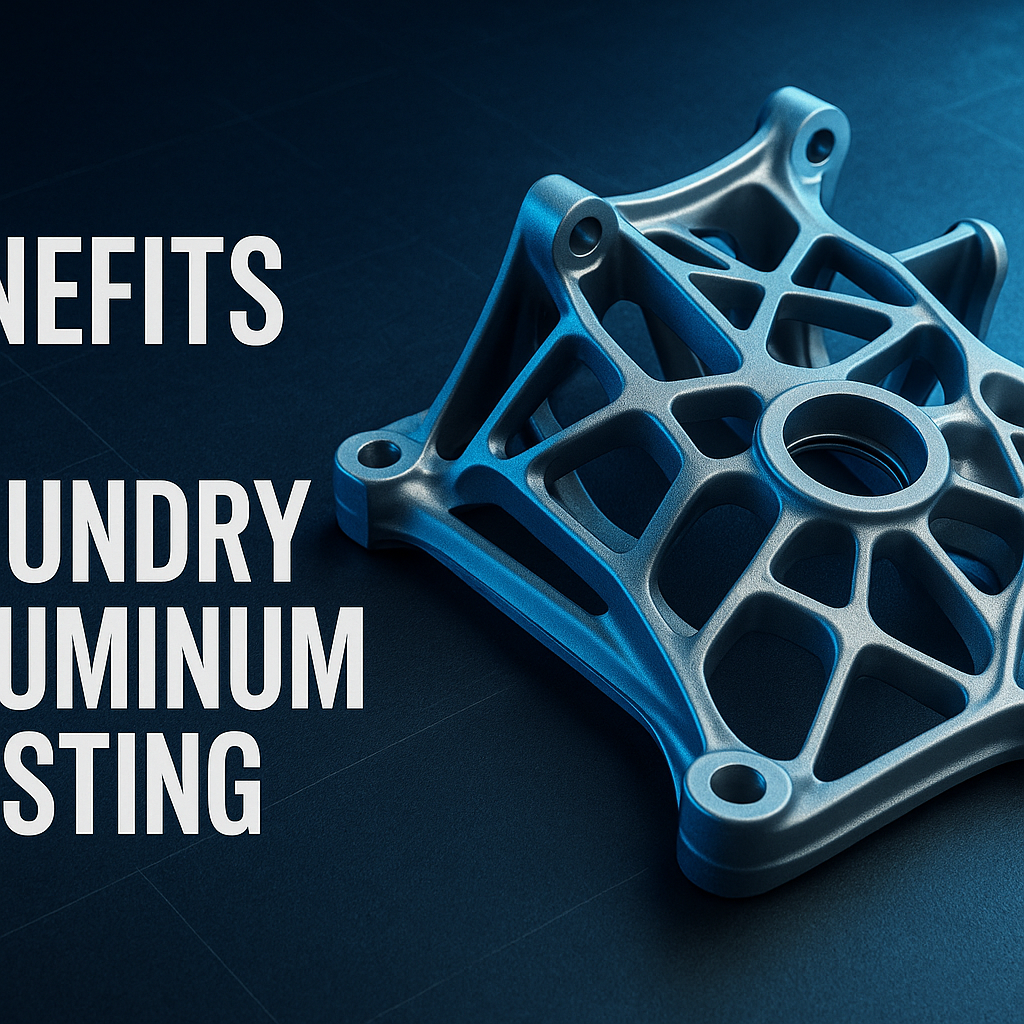
How do you maximize the strength-to-weight ratio?
We maximize the strength-to-weight ratio by using high-purity aluminum alloys that offer structural integrity without the bulk of heavier metals. This optimization is critical for industries where weight is a primary concern. The casting process allows for material to be placed precisely where it is needed for strength.
- Aerospace: Lighter components reduce fuel consumption.
- Automotive: Performance parts improve handling and speed.
- Robotics: Reduced weight enhances motor efficiency and agility.
How do you achieve superior corrosion resistance?
Superior corrosion resistance is inherent to aluminum, which naturally forms a protective oxide layer when exposed to air. We enhance this property through specific alloy selection and optional surface treatments. Here’s the deal: this makes aluminum castings ideal for use in harsh or outdoor environments.
What design freedoms does foundry aluminum casting unlock?
This process unlocks significant design freedom by enabling the creation of complex, near-net-shape parts that would be difficult or impossible to machine. This includes intricate internal passages, thin walls, and organic shapes.
Key Takeaway: Foundry aluminum casting provides a versatile manufacturing method that delivers strong, lightweight, and corrosion-resistant parts with exceptional design flexibility.
| Feature | Benefit | |
|---|---|---|
| Strength-to-Weight Ratio | Creates strong yet lightweight components. | |
| Corrosion Resistance | Ensures durability in harsh environments. | |
| Design Freedom | Allows for complex and intricate geometries. |
This combination of properties makes it a superior choice for modern engineering challenges.
Our Advanced Foundry Aluminum Casting Process
Our advanced foundry aluminum casting process is a meticulously controlled method that transforms a digital design into a precise physical component. We utilize modern technology at every stage, from mold creation to the final pour, ensuring consistent quality. This ensures your parts are manufactured to exact specifications.

How do you get from digital design to a physical part?
We begin with your CAD file to engineer and create a precise mold, often called tooling. A wax pattern is created from this mold, which is then coated in a ceramic shell.
- Step 1: Create a wax pattern from a precision-engineered mold.
- Step 2: Assemble wax patterns onto a “tree.”
- Step 3: Build a ceramic shell around the wax tree.
- Step 4: Melt the wax out, leaving a hollow ceramic mold.
What are the key stages: mold, pour, and finish?
The key stages are creating the mold, pouring the molten aluminum, and finishing the part. After the wax is removed, molten aluminum is poured into the pre-heated ceramic shell. You might be wondering: how do we get the final product? Once cooled, the ceramic is broken away, and the part is finished to your specifications.
How do you ensure precision at every step?
Precision is ensured through a combination of advanced machinery, strict process controls, and expert oversight. We use simulation software to predict metal flow and solidification, preventing defects before they occur.
Key Takeaway: Our investment casting process is a systematic, multi-stage method that guarantees high-quality, precise parts from start to finish.
| Stage | Action | Purpose | |
|---|---|---|---|
| Design | Create a wax pattern from a digital file. | To replicate the final part’s geometry. | |
| Casting | Pour molten aluminum into the ceramic mold. | To form the metal component. | |
| Finishing | Remove the shell and clean the part. | To prepare the part for use or secondary processing. |
This structured approach ensures repeatability and adherence to tight tolerances.
What Alloys Are Used for Foundry Aluminum Casting?
We use a variety of high-performance aluminum alloys for foundry aluminum casting, selected based on the specific mechanical and environmental requirements of your project. Each alloy offers a unique combination of properties such as strength, ductility, and corrosion resistance. Your application dictates the optimal material choice.
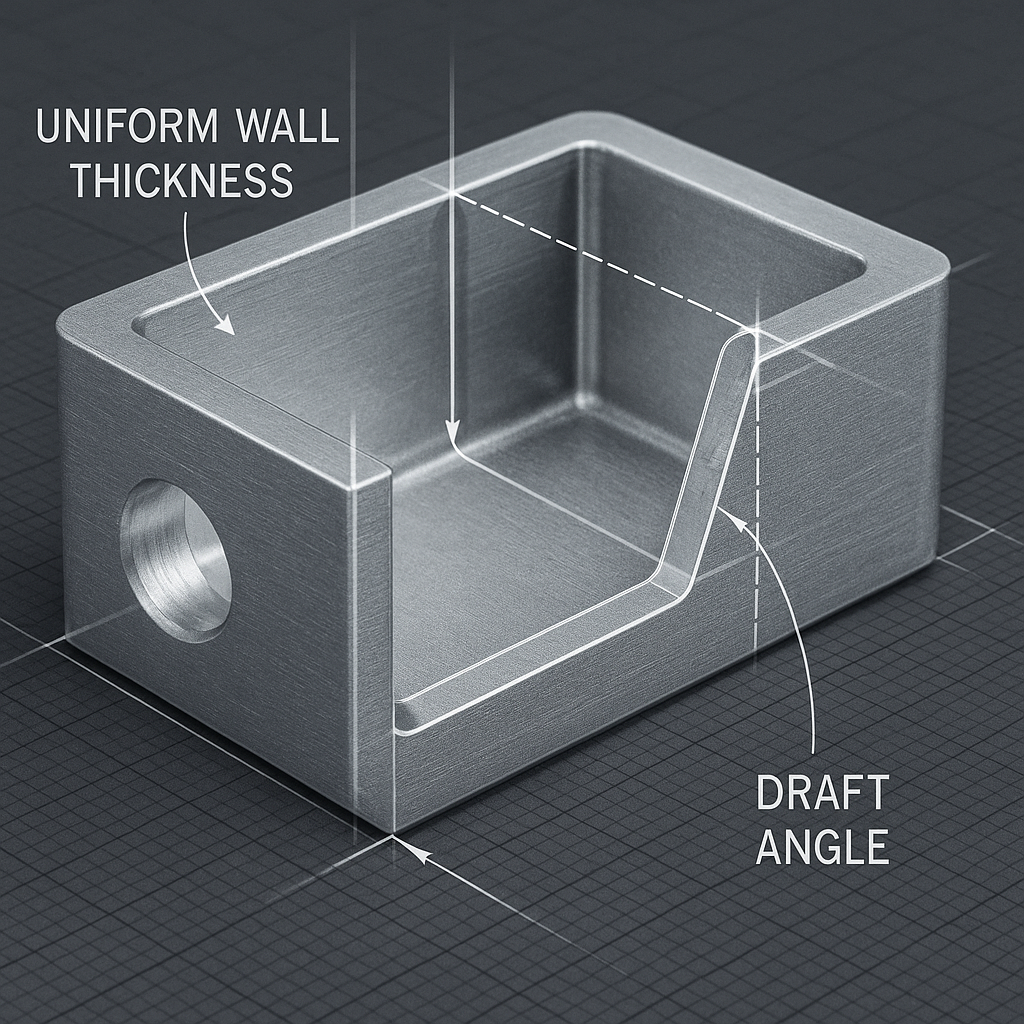
How do you select the right aluminum alloy?
Selecting the right alloy involves analyzing your part’s operational needs, such as its load-bearing capacity, temperature exposure, and desired lifespan. We consult with you to balance performance requirements with project budget.
- A356: Excellent castability and pressure tightness.
- 357: Higher strength and toughness.
- A380: Good for die casting, offering a balance of properties.
What are some high-performance alloy options?
High-performance options often include alloys with added elements like silicon, magnesium, or copper to enhance specific properties. For example, adding copper can increase strength and hardness, making the alloy suitable for more demanding applications. But that’s not all. Some alloys are specifically designed for high-temperature stability.
What are common material properties and applications?
Common properties include excellent corrosion resistance, high thermal and electrical conductivity, and a high strength-to-weight ratio. These attributes make aluminum casting a top choice for numerous industries.
Key Takeaway: The selection of the correct aluminum alloy is fundamental to achieving the desired performance and durability of your final component.
| Alloy Group | Key Property | Common Application | |
|---|---|---|---|
| Al-Si | Excellent Castability | Engine blocks, complex housings | |
| Al-Mg | High Corrosion Resistance | Marine hardware, outdoor fixtures | |
| Al-Cu | High Strength | Aerospace components, structural parts |
Matching the alloy to the application ensures optimal performance and product longevity.
How Is Quality Ensured in Foundry Aluminum Casting?
Quality in foundry aluminum casting is ensured through a comprehensive quality management system that is certified to ISO 9001:2015 standards. This system governs every stage of production, from material verification to final inspection. Our commitment to quality guarantees that every part meets or exceeds your specifications.
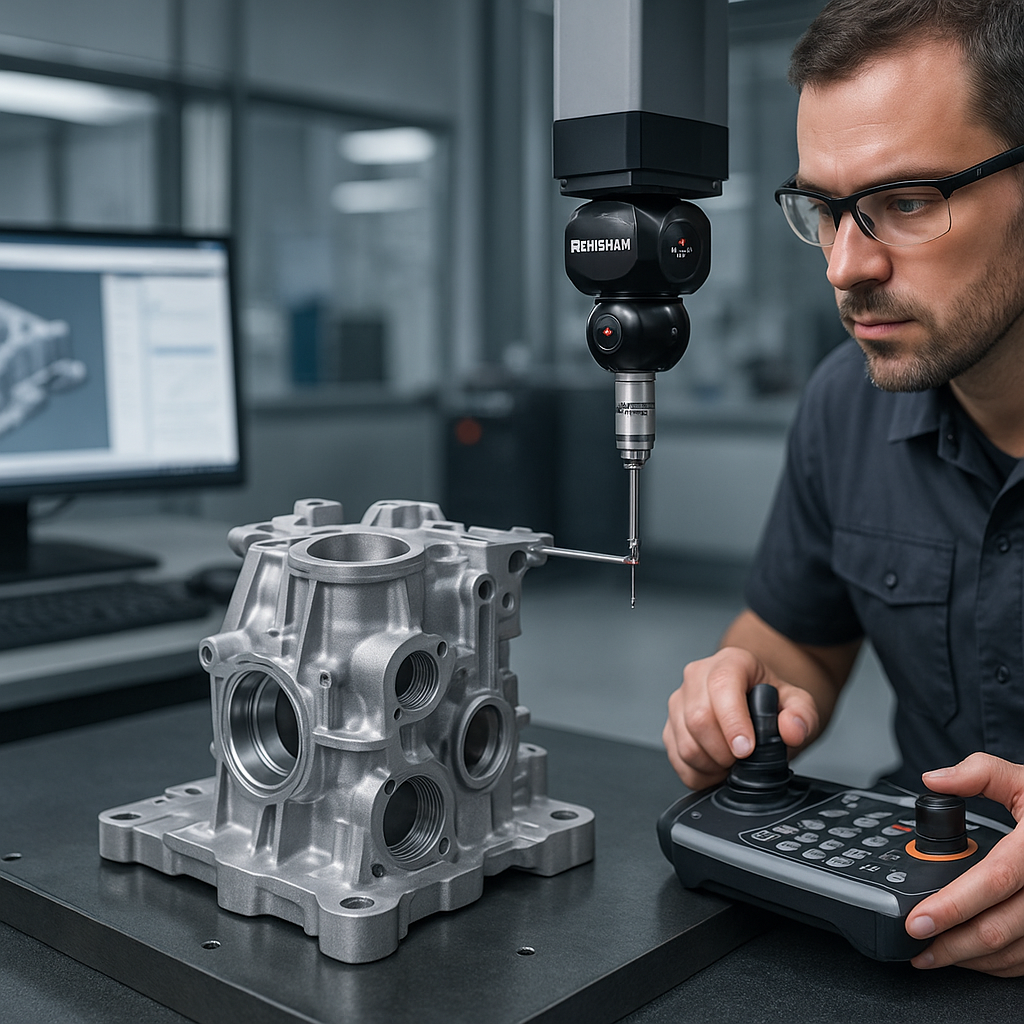
What is your ISO 9001:2015 certified process?
Our ISO 9001:2015 certified process mandates strict adherence to documented procedures for all operations. This includes rigorous control over raw materials, process parameters, and employee training.
- Material Certification: Verifying all incoming aluminum alloys.
- Process Monitoring: Tracking key variables like temperature and time.
- Final Inspection: 100% inspection of critical dimensions.
What advanced inspection and testing methods are used?
We utilize a suite of advanced inspection tools, including Coordinate Measuring Machines (CMM) for dimensional verification, X-ray testing for internal integrity, and spectrometry for alloy composition analysis. What’s the bottom line? These methods allow us to detect and correct any deviations from the standard.
How do you meet tight dimensional tolerances?
Meeting tight tolerances requires a deep understanding of metal shrinkage and part geometry. We design our tooling to compensate for these factors and use advanced CNC machining for features that require the highest level of precision.
Key Takeaway: A multi-layered approach to quality control ensures that our foundry aluminum casting services deliver parts with consistent accuracy and integrity.
| Quality Method | Purpose | |
|---|---|---|
| ISO 9001:2015 | Guarantees a standardized, repeatable process. | |
| Advanced Inspection | Verifies dimensional accuracy and material integrity. | |
| Tight Tolerance Control | Ensures parts fit and function as designed. |
This rigorous quality framework is central to our ability to produce reliable, high-performance parts.
How to Design for Foundry Aluminum Casting?
Designing for foundry aluminum casting involves optimizing your part’s geometry for the manufacturing process to ensure quality and cost-effectiveness. This means considering factors like wall thickness, draft angles, and parting lines from the outset. A well-designed part is easier to cast and requires less finishing.

What are best practices for part design?
Best practices include maintaining uniform wall thickness to promote even cooling and prevent defects. It’s also important to incorporate generous radii at corners to reduce stress concentrations.
- Uniform Wall Thickness: Avoids shrinkage and porosity.
- Draft Angles: Allow for easy removal from the mold.
- Generous Fillets: Prevent cracks and improve metal flow.
- Parting Line Placement: Optimize for aesthetics and function.
How can you optimize for manufacturability?
To optimize for manufacturability, simplify your design where possible without compromising function. This is where it gets interesting. Consolidating multiple parts into a single casting can drastically reduce assembly time and costs.
How do you collaborate with our engineers?
Collaborating with our engineers early in the design phase allows you to leverage our deep expertise in investment casting . We provide Design for Manufacturability (DFM) feedback to identify potential issues and suggest improvements.
Key Takeaway: Thoughtful design that adheres to casting principles is crucial for producing high-quality, cost-effective aluminum parts.
| Design Principle | Rationale | |
|---|---|---|
| Uniform Walls | Ensures consistent cooling and prevents defects. | |
| Draft Angles | Facilitates easy part removal from the mold. | |
| Simple Geometry | Reduces tooling complexity and lowers cost. |
Early design collaboration with casting experts is the most effective way to optimize your part for production.
What Finishing Is Available for Foundry Aluminum Casting?
A wide range of finishing options is available for foundry aluminum casting to enhance mechanical properties, improve appearance, and add protective layers. These post-casting processes are tailored to meet your part’s specific functional and aesthetic requirements. From machining to coating, we offer a full suite of services.
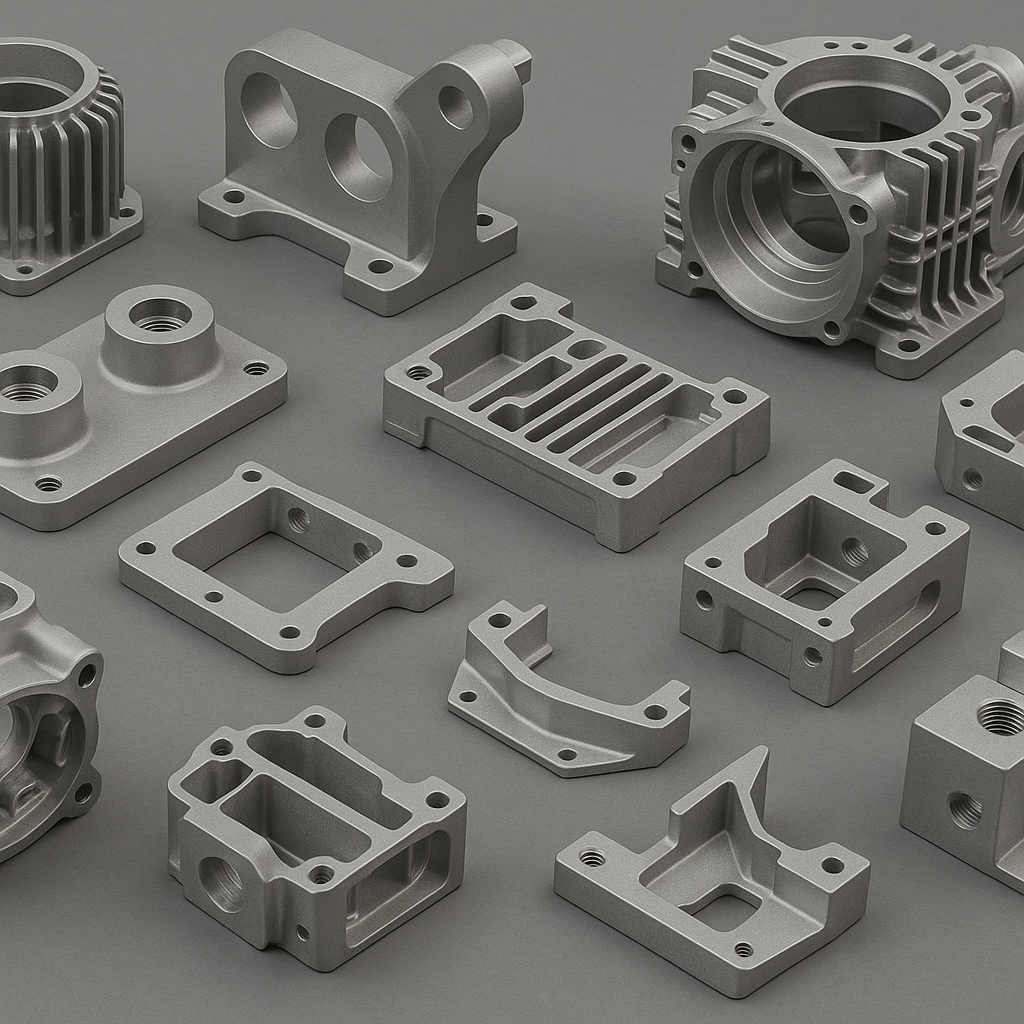
What precision CNC machining services are offered?
Our precision CNC machining services create features with extremely tight tolerances that casting alone cannot achieve. This includes drilling and tapping holes, milling flat surfaces, and turning cylindrical features. We can machine parts to final dimensions after casting.
- 3-axis and 5-axis CNC milling
- CNC turning and lathing
- Drilling, reaming, and tapping
How is heat treatment used to enhance strength?
Heat treatment alters the microstructure of the aluminum alloy to improve its mechanical properties, such as hardness and tensile strength. Here’s the deal: processes like solution heat treating and aging can significantly boost the performance of your cast parts. Explore our casting heat treatment services for more details.
What surface finishing and coating options are there?
We offer various investment casting surface treatments to improve corrosion resistance, wear resistance, and aesthetics. Options include anodizing, powder coating, and painting. The right finish depends on your part’s end-use environment.
Key Takeaway: Post-casting finishing services are essential for transforming a near-net-shape casting into a fully functional, production-ready component.
| Finishing Service | Purpose | |
|---|---|---|
| CNC Machining | Achieves tight tolerances and complex features. | |
| Heat Treatment | Enhances strength, hardness, and durability. | |
| Surface Finishing | Improves corrosion resistance and appearance. |
These value-added services provide a one-stop solution for your finished part needs.
Which Industries Use Foundry Aluminum Casting?
Foundry aluminum casting is used by a diverse range of industries that require high-performance, lightweight, and complex components. Its unique combination of properties makes it a go-to manufacturing solution for sectors from aerospace to medical. The versatility of the process allows for custom solutions across many fields.
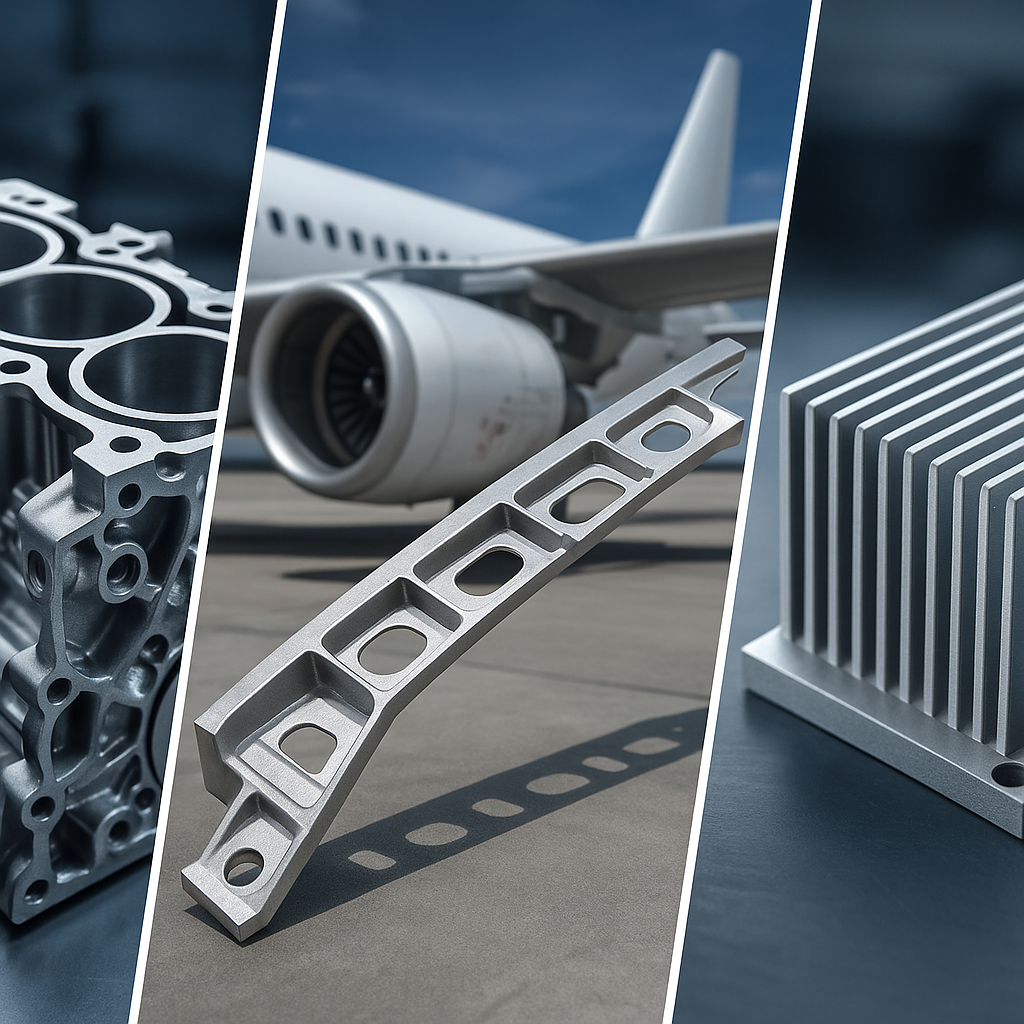
What are some aerospace and defense applications?
In aerospace and defense, every gram matters, making aluminum casting ideal for manufacturing lightweight structural components, avionics enclosures, and engine parts.
- Aircraft seat frames
- Guidance system housings
- Drone components
- Brackets and supports
What are some automotive and performance parts?
The automotive industry relies on foundry aluminum casting for engine blocks, transmission housings, and suspension components to reduce vehicle weight and improve fuel efficiency. You might be wondering about performance. High-performance vehicles use cast aluminum for parts like wheels and intake manifolds.
What is it used for in medical and industrial equipment?
In the medical and industrial fields, aluminum casting is used for equipment housings, robotic arms, and diagnostic machine components due to its strength, durability, and corrosion resistance. It offers the precision needed for sensitive applications.
Key Takeaway: The adaptability of foundry aluminum casting makes it a critical manufacturing process for industries demanding precision, strength, and low weight.
| Industry | Example Application | Key Benefit | |
|---|---|---|---|
| Aerospace | Avionics Housings | Lightweight & Durability | |
| Automotive | Engine Blocks | Weight Reduction & Performance | |
| Medical | Equipment Enclosures | Precision & Corrosion Resistance |
The widespread adoption across these demanding sectors highlights the process’s reliability and versatility.
What Complex Foundry Aluminum Casting Solutions Exist?
Complex foundry aluminum casting solutions enable the production of parts with intricate geometries, thin walls, and integrated features that are not feasible with other methods. Our advanced capabilities allow us to tackle the most challenging designs. We specialize in turning complex concepts into tangible, high-quality components.

How are intricate geometries manufactured?
Intricate geometries are manufactured using sophisticated multi-piece molds and soluble or ceramic cores. These techniques create complex internal channels and hollow sections within a single, seamless part.
- Soluble Cores: Dissolve after casting, leaving internal voids.
- Ceramic Cores: Are mechanically removed to create channels.
- Multi-Piece Molds: Allow for undercuts and complex external features.
What are your thin-walled casting capabilities?
Our process allows for the casting of parts with walls as thin as 1.5mm, depending on the part’s overall size and complexity. This capability is essential for creating lightweight enclosures and housings. But that’s not all. Careful control of metal flow and temperature is critical to achieving these results without defects.
Do you offer prototyping and low-volume production?
Yes, we offer rapid prototyping and low-volume production to help you validate your designs before committing to expensive production tooling. We use various techniques, including 3D-printed patterns, to create functional prototypes quickly.
Key Takeaway: Our expertise in complex foundry aluminum casting allows us to produce highly integrated and optimized parts for demanding applications.
| Capability | Description | Advantage | |
|---|---|---|---|
| Intricate Geometries | Manufacturing complex internal and external features. | Part consolidation and improved performance. | |
| Thin-Walled Casting | Creating parts with walls as thin as 1.5mm. | Significant weight reduction. | |
| Prototyping | Fast-turnaround parts for design validation. | Reduced development risk and faster time-to-market. |
These advanced solutions push the boundaries of what is possible with aluminum casting.
What Is the Cost of Foundry Aluminum Casting?
The cost of foundry aluminum casting is determined by several key factors, including part complexity, tooling requirements, material choice, and order volume. While it provides a cost-effective solution for complex parts, understanding the cost structure is important for project budgeting. A detailed quote will break down these elements for you.
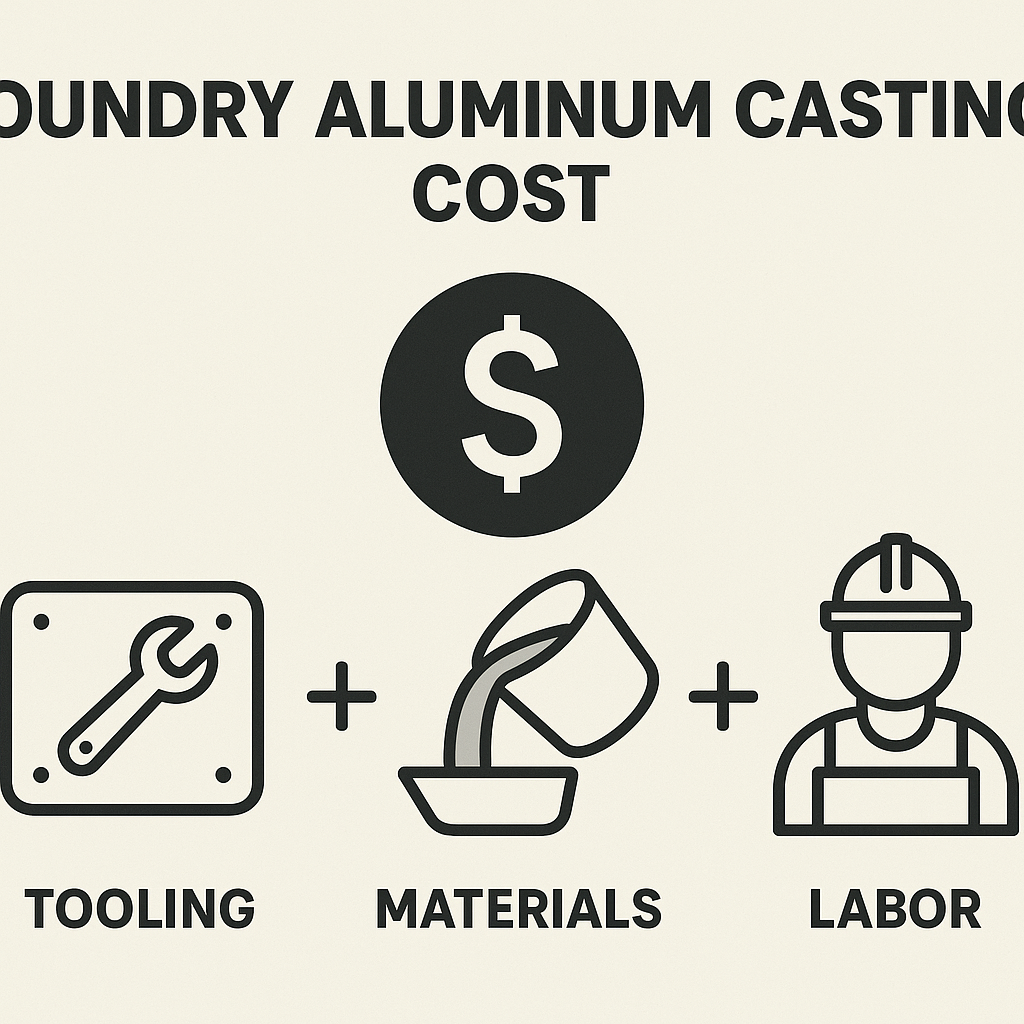
What factors influence project cost?
Project costs are influenced by the part’s size, weight, and complexity, as well as the alloy specified and the required finishing services. More complex designs require more intricate tooling and more labor.
- Part Complexity: Intricate designs increase tooling costs.
- Aluminum Alloy: Higher-performance alloys are more expensive.
- Order Volume: Larger quantities reduce the per-part cost.
- Finishing: Machining, heat treatment, and coating add cost.
How does tooling vs. per-part pricing work?
Tooling is typically a one-time, upfront cost to create the mold for your part. The per-part price covers the materials, labor, and machine time for each component produced. What’s the bottom line? Higher volume orders amortize the tooling cost over more parts, lowering the effective unit price.
How can I get an accurate project quote?
To get an accurate quote, provide a 3D CAD file of your part along with specifications for the material, required tolerances, and any finishing services. Clearly defining your project requirements helps us provide a comprehensive and precise quote.
Key Takeaway: Understanding the cost drivers of foundry aluminum casting allows you to optimize your design for both performance and budget.
| Cost Component | Description | Primary Driver | |
|---|---|---|---|
| Tooling | The one-time cost to create the production mold. | Part Complexity | |
| Per-Part Price | The cost to produce each individual component. | Material & Labor | |
| Finishing | Costs for secondary operations like machining. | Service Requirements |
A detailed RFQ (Request for Quote) is the best way to get a clear picture of your total project cost.
What Is the Future of Foundry Aluminum Casting?
The future of foundry aluminum casting is being shaped by innovations in automation, sustainability, and materials science. These advancements are making the process more efficient, environmentally friendly, and capable of producing even higher-performance parts. As a forward-looking partner, we are actively integrating these new technologies.
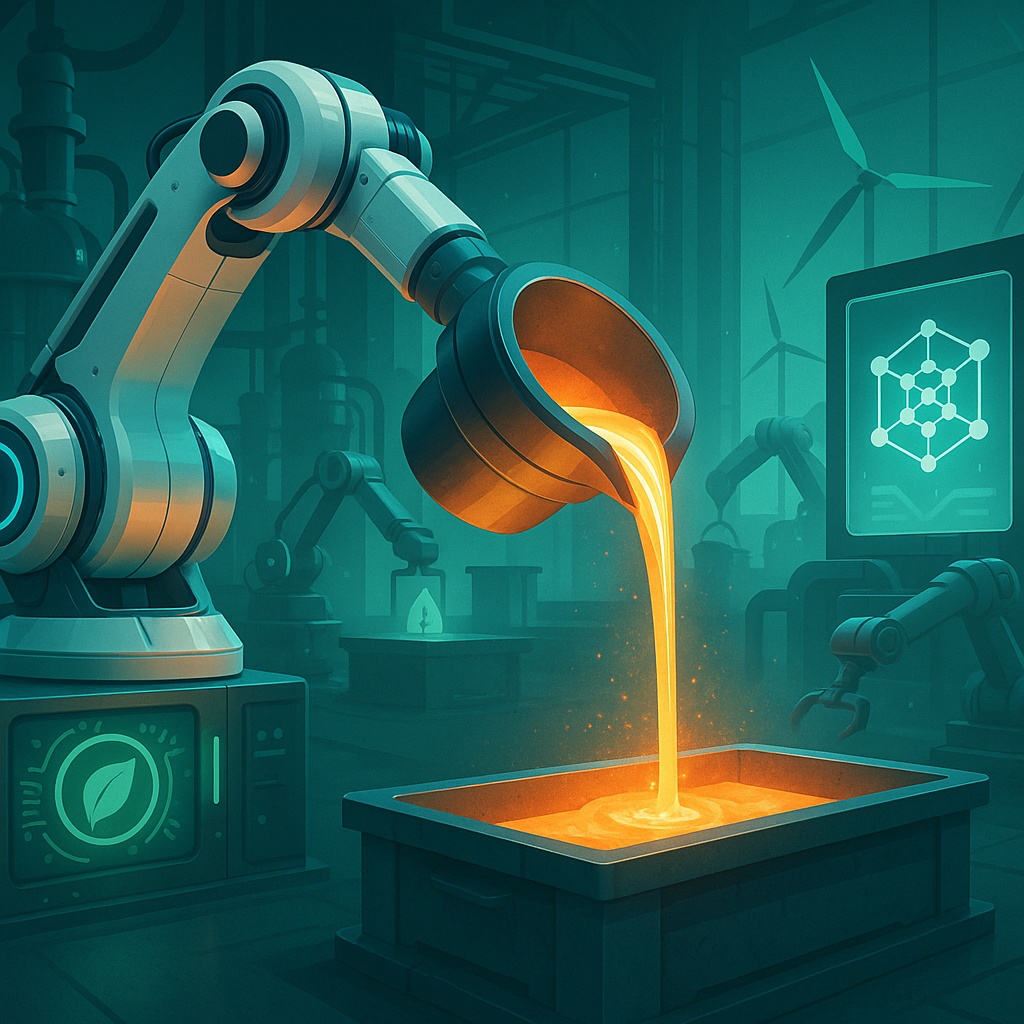
What are the latest innovations in casting tech?
Innovations include the use of robotics for process automation, advanced simulation software for “first-time-right” casting, and 3D printing for creating complex patterns and even direct-to-metal parts.
- Robotic Automation: For shell building and metal pouring.
- Advanced Simulation: Predicts and eliminates defects digitally.
- Additive Manufacturing (3D Printing): Enables rapid prototyping and complex tooling.
How are sustainable and efficient practices being used?
Sustainability is being driven by the increased use of recycled aluminum, which requires significantly less energy to process than primary aluminum. This is where it gets interesting. Foundries are also adopting more energy-efficient furnaces and implementing waste-reduction programs to minimize their environmental footprint.
How can we partner for long-term success?
Partnering for long-term success involves early collaboration on new product designs and a commitment to continuous improvement. By working together, we can leverage emerging technologies to optimize your components for performance, cost, and manufacturability.
Key Takeaway: The foundry aluminum casting industry is evolving rapidly, with new technologies paving the way for more efficient, sustainable, and capable manufacturing.
| Trend | Impact | |
|---|---|---|
| Automation & Robotics | Improved consistency and efficiency. | |
| Sustainability | Reduced energy consumption and waste. | |
| Advanced Materials | Lighter, stronger, and more durable alloys. |
Partnering with a forward-thinking foundry ensures you can capitalize on these advancements.
Frequently Asked Questions (FAQ)
- Can I get a prototype before committing to full production?Yes, we offer rapid prototyping services to help you test and validate your design with a functional part before investing in production tooling.
- What’s the best aluminum alloy for high-stress applications?For high-stress applications, alloys with higher tensile strength and toughness, such as those in the 357 or certain 2xx series, are often recommended, sometimes combined with heat treatment.
- What dimensional tolerances can your process hold?We can typically hold standard linear tolerances of +/- 0.13mm for the first 10mm, with additional tolerance for larger dimensions. Tighter tolerances can be achieved with secondary machining. Please see our page on investment casting tolerance for more details.
- Can you accommodate highly complex part geometries?Absolutely. Our investment casting process is specifically suited for producing parts with highly complex internal and external geometries that are difficult or impossible to make with other methods.
- What is the typical lead time for a new casting project?Lead time varies based on complexity. For new tooling and first articles, it is typically 4-6 weeks, with subsequent production runs being faster.
Conclusion
Leverage the power of precision-engineered components to bring your designs to life. Our expertise in foundry aluminum casting ensures you receive parts that are not only strong and lightweight but also perfectly aligned with your project’s unique demands. By implementing these proven strategies, you can turn your concepts into reliable, high-performance realities.
Ready to move from concept to creation? Contact our engineering team today to discuss your project requirements and receive a comprehensive quote.



